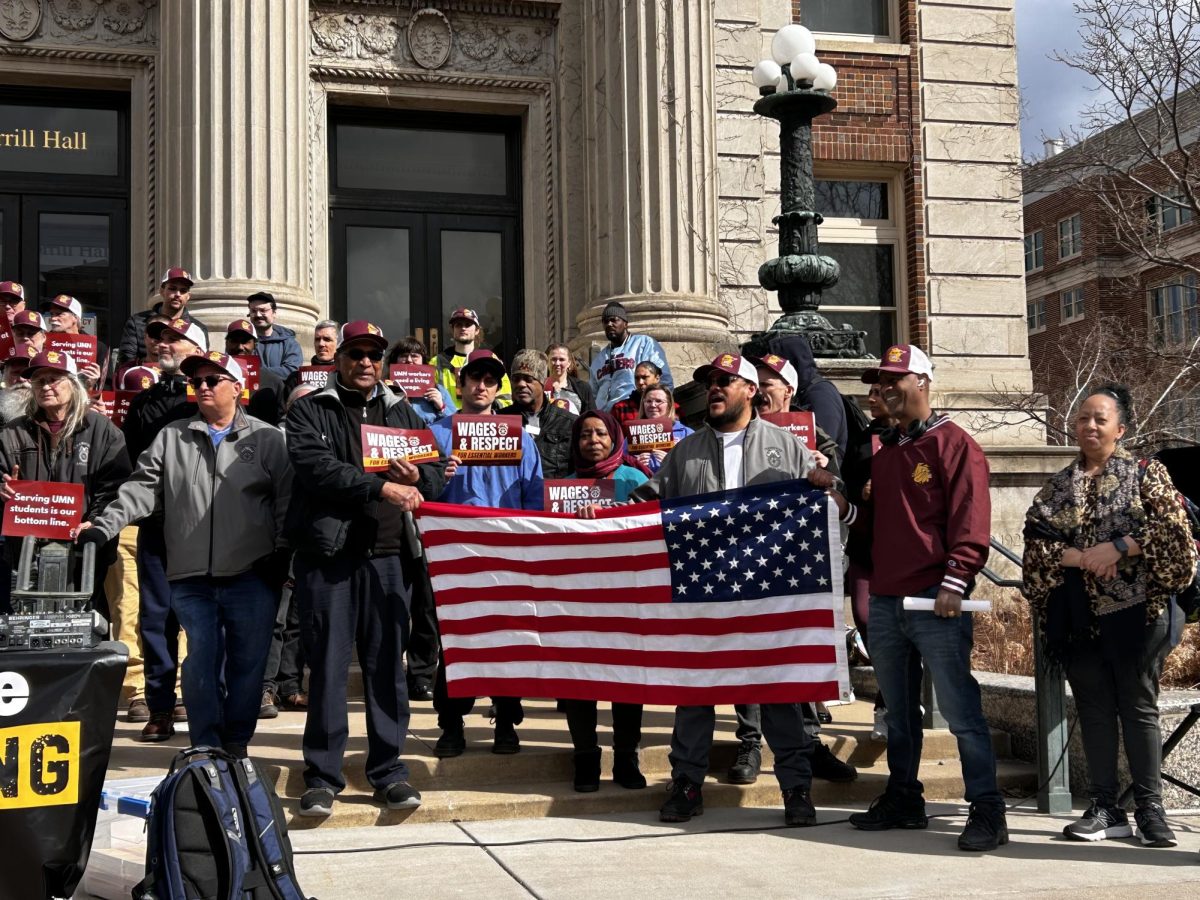As rain poured down on campus Saturday, student protesters gathered at the McNamara Alumni Center plaza to call for the University of Minnesota’s support of abortion rights for students and faculty.
University student group Students for a Democratic Society (SDS) organized the protest, presenting demands for University President Joan Gabel to provide abortions on campus and establish a center to provide reproductive services to students, among other measures. About 100 people marched down Washington Avenue to Morrill Hall, where Gabel’s office is located.
“Our primary campaign right now is pressuring the University to be on the frontlines leading the fight for more abortion access,” SDS member Olivia Crull said as she addressed the crowd. “It’s about the people in power actually prioritizing the needs of the people who are being affected by these issues.”
The protest on Saturday was the second protest that SDS organized in response to the U.S. Supreme Court decision to overturn Roe v. Wade, removing constitutional protection for abortion. The first protest organized by SDS condemning the ruling took place after the decision was announced on June 24, with about 10,000 protestors in attendance.
The goal of the protest Saturday was to carry on the momentum from the first protest and keep people passionate about the issue, said member of Freedom Road Socialist Organization Mira Altobell-Resendez, who graduated from the University in May.
“We just want to keep a spotlight on this issue,” Altobell-Resendez said. “We really just want to keep the ball rolling with that for as long as we can so that we can reach a victory for our demands.”
In front of the Alumni Center, SDS member Robyn Harbison spoke to the crowd and announced the student group’s demands for the University.
The demands include the creation of a reproductive health training module to be included in freshman orientation and a “reproductive health advocacy and education center” on campus, as well as the opening of an abortion clinic on campus.
The University of Minnesota operated an abortion clinic on campus that closed in 1975 because three members of the OB-GYN department quit, and “there were no other people to fill these positions,” according to record of a 1977 Board of Regents meeting. University President from 1974 to 1984, Peter Magrath, released a statement that year saying he supported keeping the clinic closed because “this was not a number one priority item,” and 10 to 15 other Twin Cities clinics and hospitals performed abortions at the time.
SDS also called for a boycott by the University of events and purchases from states with heartbeat bills, which prohibit abortion of a fetus once a heartbeat is detected, usually at about six weeks of pregnancy.
“Our final demand is for the University to boycott events or purchases or anything like that from states that have active heartbeat bills in order to bring down their economies so they know it’s not acceptable for them to restrict people’s rights to bodily autonomy,” Altobell-Resendez said.
The University was unable to release a statement addressing the demands of SDS before publication.
Eight abortion clinics currently operate in Minnesota. The closest to the University’s Twin Cities campuses is Planned Parenthood’s St. Paul Vandalia health center.
“We would love to see the addition of many more abortion clinics that are safe and are run by well educated doctors in order to provide the abortions that are needed for people in Minnesota,” Altobell-Resendez said. “If we’re going to be a sanctuary state for the surrounding states of the Midwest, for people who are coming to seek abortions, we need the capacity to serve them as well because they deserve that just as much as anyone else.”
Crull also stressed the importance of supporting abortion clinics on the other University campuses during her speech in front of Morrill Hall.
“It is absolutely unacceptable that you would have to travel three plus hours to access these resources,” Crull said.
Many of the activists were University students or alumni and expressed hope for change within the University system.
Sara Marshal graduated from University of Minnesota-Rochester in 2020 and said the University’s power within Minnesota’s healthcare system makes it necessary for them to “do a lot more” to protect abortion rights.
“They should take this opportunity to step up and be for the people instead of the state and corporations,” Marshal said.
Other activists say they came to continue protesting the overturn of Roe v. Wade, feeling the first protest the day of the ruling wasn’t enough to stand up against the Supreme Court ruling.
Many expressed their frustrations through signs with messages like “Abort the Supreme Court” and “We will not go back.” As they marched, organizers called out chants such as “Abortion is a human right. This is why we have to fight.”
“I want to decide to do what I want to do with my body and not the state,” protestor Selena McKnight said. “You have a right to choose. And what’s best for you is not always what’s best for me, and I get to decide that, so that’s what I’m fighting for.”



















